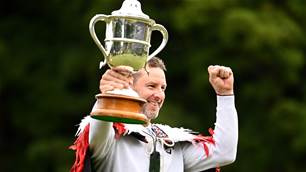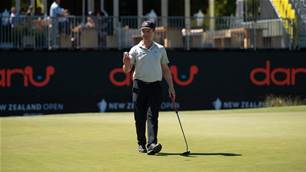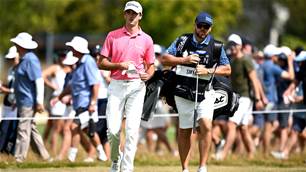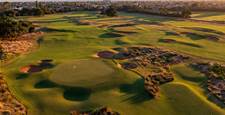For the purist, nothing quite tugs on the heartstrings like reminiscing about the glory days of national Opens.
Across the globe as a whole, the prestige of national championships has sadly dwindled unless there is a Claret Jug or U.S Open trophy on the line, but that certainly isn’t the case for the players who earn a tee-time at these iconic fixtures on the golfing calendar. For them, the desire to call yourself a national Open champion still burns strong.
Some players who have held various national titles have a heartfelt love affair with their victories. These players have also been some of the most dominant around the globe at different periods, even reaching world No. 1.
Rory McIlroy and Lee Westwood both come to mind, always speaking about the national championships they have won in the highest regard.
“The national titles are a pretty big deal, especially when you look at the trophy and see the list of winners that have gotten their name on them,” McIlroy said after his Scottish Open triumph in 2023.

You could also see how much it stung him last year when he let his own national title slip through his fingers – the Irish Open – at Royal County Down in Northern Ireland, a short drive from where the four-time major champion grew up.
These events are still circled on golfers’ and purists’ calendars and are riddled with layers of magnificent history, which is ongoing.
The New Zealand Open is steeped in plenty of its own history. Since 2007, the event has been held in the highly sought-after golfing and tourist destination of Queenstown in New Zealand’s deep south, being played at Millbrook Golf Resort’s Coronet and Remarkables courses, named after the mountain ranges which provide such breathtaking backdrops for the two layouts. Composite courses of the two are used on the weekend. The tournament has also spent much of its tenure in Queenstown at the exclusive The Hills Golf Club.

Now co-sanctioned by the PGA Tour of Australasia and the Asian Tour, the first NZ Open was held in 1907 at Napier Golf Club, “Waiohiki” as a 36-hole tournament open to professionals and amateurs across the globe. In 1908, the event was extended to 72 holes. The tournament wasn’t contested during the war years or the Covid-19 pandemic, but it celebrated its centenary in 2019.
Since 1923, the winner has been awarded the Brodie Breeze Trophy, named after notable golf club maker G. Brodie Breeze of Glasgow. The other two trophies up for grabs are the Jellicoe Cup, presented to the player who records the lowest round of the championship, and the Bledisloe Cup, awarded to the low amateur. Although the name might sound familiar to rugby union fans, this Bledisloe Cup isn’t the one the All Blacks have kept in their trophy cabinet since 2002.
Plenty of world-class players have headed down to the land of the long white cloud to contest the Brodie Breeze, and certainly not all of them have walked away with the prized silverware.
Tiger Woods played at Paraparaumu Beach in 2002 and failed to hoist any silverware. U.S Open champion from 1995, Corey Pavin, won the NZ Open at the same venue in 1984 and defended his title at Russley Golf Club in Christchurch the following year.

Australian legends Peter Thomson (nine titles) and Kel Nagle (seven titles) dominated through the 1950s, ’60s, and into the ’70s. Ian Baker-Finch clinched the 1983 title by three strokes over local pro Stuart Reese.
Throughout this period, Kiwi golfers have tasted some success. New Zealand’s best male players – and major champions – Michael Campbell (2000) and Sir Bob Charles (1954 as an amateur, 1966, and 1973) are just two New Zealanders who have written their names in the history books as champions of their national open. Michael Hendry was the last local to claim the Brodie Breeze in 2017, and apart from last year’s champion, Japan’s Takahiro Hataji, it has been a happy hunting ground for the Australians in recent times.
Why? The obvious argument is that the percentages are in their favour – there are more Australians in the field. But it is no secret that the trans-Tasman rivalry still burns deep. Aussies want to jump the ditch and pinch New Zealand’s open.

Golf Australia Magazine spoke to two former champions who reminisced fondly about their time in New Zealand’s deep south.
It is coming up on 10 years since Victoria’s Matthew Griffin claimed the Brodie Breeze in 2016 across The Hills and Millbrook layouts, and he ranks it right up there with one of his biggest wins.
“I think you just look at the rich history of all the opens. I remember when I won, I was fortunate enough to get a call from Peter Thomson, who said, ‘Well done, mate. You’ve got [eight] more to catch me,’” Griffin says.
“But I think you look down at the trophy, and you see all the names on it. It’s just nice to be amongst some great names in Australia, New Zealand, and world golf.”
Griffin has played his fair share of national opens, and as well as his win in 2016, he put himself in the mix to become a two-time NZ Open champion last year, finishing in a tie for third.
With all of his experience, Griffin is high in praise for the way the tournament is set up and run; it feels like a big event, looks like a big event, and it is a big event. One of the biggest on the PGA Tour of Australasia calendar, it continues to improve year on year, according to the 41-year-old.
“Over the last 10 years, it just got that little bit better every year. When you arrive in Queenstown and get to the golf course, it feels like a big tournament. And, well, very close, if not better, than what the Australian Open is now as well – I’d have it on par myself.
“I think what the tournament staff and directors need to be commended on is how the event has really grown over the time that I played it.”
 Victorian Zach Murray was just a few months into a professional career when he went wire-to-wire and won the 100th edition of the New Zealand Open in 2019 across Millbrook and The Hills.
Victorian Zach Murray was just a few months into a professional career when he went wire-to-wire and won the 100th edition of the New Zealand Open in 2019 across Millbrook and The Hills.
He became the fastest rookie to win on the Asian Tour and earned playing rights on the tour, along with his victory, springboarding his career rapidly.
RIGHT: Lucas Herbert had a close call last time he played in the NZ Open. PHOTO: Getty Images.
So early in his career, he had the pressure of holding off a surging local in Josh Geary and did a brilliant job. He – like Griffin – holds his win in Queenstown in very high regard and has fond memories of his week in 2019.
“I was obviously pretty young; only 21, and probably pretty naive about the whole situation, to be honest,” Murray says.
“I had only been pro two or three months, and I knew Josh was a really good player. I mean, Ash Hall made a charge earlier in the day as well. Honestly, I probably did a really good job focusing on myself that day.
“The memory of it was pretty clear that I was in front all day, and then I saw that I wasn’t, and then I just had to put the foot on the gas. Fortunately, it just worked out for me.”
Like all travellers who step foot on their respective flights in Queenstown, the glorious views are enough to make you think about your next trip back. Murray is no different; his memories stretch further than his win at The Hills.
“There are a lot of fond memories that I have there. It is probably my favourite place in the world, apart from home.
“So, I think I’ll never forget the first time I stepped off the plane there and looked up at the mountains, and I was just like, ‘Jesus, this is a little bit different to where I’m from,’” Murray laughs.
“I mean, even thinking about it now, it’s just a super exciting place to get back to every year.”

Lining up for national titles is still a huge deal, especially for guys playing in their own. For a young guy, it is great to hear how vital national opens still are to Murray.
“I think national opens across the globe are regarded equally as the fifth major, whether it be the Australian Open or anywhere else.
“I think for everyone, especially if it’s your national open, it’s always the first event you’re looking at on the schedule.”
As established, it is no secret that Australians have dominated the NZ Open. Murray says the inner Australian vs New Zealand competitive spirt may have something to do with it.
“Probably just a little bit of that Australian-Kiwi rivalry, to be honest.
“Maybe there’s just a little bit of that inner rivalry when it comes down the stretch that gets a few of the boys across the line, but equally the same with the Kiwis.
“I think there’s always just a great rivalry between us. I don’t know the statistics on the field, but I think there are predominantly more Australians in the field. Just weight in numbers also plays a big part in that,” Murray admits.
The Millbrook layouts certainly aren’t the most brutal loops these guys will play on tour. They are plenty wide enough to allow some margin for error. There is also a pro-am unfolding, so the courses will naturally not play as hard as they could. Scoring is typically low, and players will need to make a good number of red figures to win the Brodie Breeze.
It is essential to always have looks at birdie and not fall too far behind the leader of the peloton.
“I think for me, the week that I won, I just kept myself in play and gave myself a lot of looks. I think the big part on those courses is putting,” Murray said about the setups.
“Most guys will have a lot of looks because it’s predominantly pretty wide, or if it’s not, it’s irons off the tee.
“You are always going to have short irons [into the green], and it basically just becomes an inside-150-metres competition. So that’s probably the big factor in playing well across both of those courses.”
The pro-am format is contentious in golfing circles. The New Zealand Open is in the minority, too; it is the only national open which adopts the format.
“In America, if you think pro-am format, most people, if you put the gun to their head and said, ‘Right, name a pro-am format in America,’ they’d say AT&T [Pebble Beach]. If you said that in Europe, they’d say the Dunhill Links. We wanted to be this partof the world’s equivalent. That’s what we’ve set out to create,” NZ Open tournament director Michael Glading told Golf Australia magazine.
Along with being one of the staple events on the PGA Tour of Australasia calendar, the co-sanctioning with the Asian Tour and continuing its partnership with the Japan Tour has been monumental for the NZ Open. Along with this, the winner will also receive an invite to The Open Championship at Royal Portrush.
“We have three sponsorships that emanate out of Southeast Asia, and that’s unashamedly where we focus our international appeal. We’ve had government support now for over 10 years, and the government support was predicated on the basis that our ties of the future need to be with Asia,” Glading added.

With a purse of NZD 2M, it isn’t short of a good pay packet. But what the NZ Open has done for players who miss the cut is grant $1,000 each as a bit of a tip of the cap for coming down and playing in their event.
“Every player who misses the cut is going to get $1,000.
“We just feel that that’s a bit of a nod to the fact that it does cost money to come to Queenstown. A lot of the guys out of pocket don’t get that.
“More than half the field [normally] goes home empty-handed. We’ve allocated a sum of money for that,” Glading says.
 Glading also explains that there have been a few changes around the composite course for the weekend.
Glading also explains that there have been a few changes around the composite course for the weekend.
“The changes we’ve made really revolve around the composite course compared with last year.
RIGHT: The Pro-am brings in some big names. PHOTO: Getty Images.
“We’re keeping all of the holes close to the Village Green or Central area.
“It’s just that we’re changing the batting order a little bit, but we still finish with the par-3.”
A strong field will assemble in Queenstown this year: the two former champions we spoke to, Kiwi LIV stars Ben Campbell and Danny Lee, the defending champion Hataji, and plenty of local and international hopefuls, including nine out of the top 20 on the Japan Golf Tour Order of Merit at the time of writing, all setting their sights on national open glory.
You can make a case for plenty of them. However, this writer will make a case for three of them. Call it Golf Australia magazine’s best chances at the New Zealand Open.
THE CONTENDERS
Lucas Herbert
Pretty much every week he has spent down under this season, Ripper GC’s Herbert has looked in control. He won the NSW Open over his LIV skipper, Cam Smith. He contended at the Australian Open before a final-day 74 saw him finish in a tie for fifth.
Herbert comes into the NZ Open fresh off an electric but dissapointing week at LIV Adelaide, where Ripper GC failed to go back-to-back in the team event. He is fresh and has plenty of reps under his belt, and you could argue that if you put world rankings to one side, he is still the best player in the field.
He is no stranger to playing in New Zealand either; he came extremely close to winning the title in 2020, finishing runner-up to countryman Brad Kennedy.
He knows his way around the venues, has no glaring weaknesses in his game, and has made it very clear that the loss in 2020 stung.
“It still haunts me; it’s a title I would have loved to have on the mantlepiece,” Herbert told New Zealand’s 1News.
A winner on the PGA Tour and a multiple winner on the DP World Tour, he isn’t going down there to merely collect a participation medal.
Ryo Ishikawa
They don’t come much cooler than Ishikawa, another guy with plenty of PGA Tour experience. Ishikawa is a smooth mover, super-calm under pressure and has 20 wins on the Japan Tour. He knows how to get over the line.
The two-time Presidents Cup representative is making his first trip down to Millbrook and is a guy with a massive amount of experience.

He won twice in Japan last year. His form is great, and he is one of the cleaner ball strikers going around; this will never hinder a player’s chances anywhere, and it will undoubtedly help in Queenstown.
Ishikawa has always been a magnificent iron player. He will hit plenty of greens, and as former champ Zach Murray says, having lots of birdie chances will be crucial. Ishikawa has every chance of having plenty, and if he takes them, running him down could be a tall task.
Daniel Hillier
Perhaps the best local chance in the field, Hillier will look to become just the second Kiwi in the last 22 years to hoist the iconic piece of silverware and proudly drape the prestigious feathered Maori cloak, Kahu huruhuru, over his shoulders.
Another world-class ball striker, Hillier is one of the best I have ever seen in the flesh. Where he can get into strife is around the greens, and Millbrook is relatively easy to combat here; there isn’t anything that should concern a player of Hillier’s calibre.

Hillier has been vocal about lining this tournament up; he wants to win, and his game looks excellent.
The Wellington product is coming off a fantastic finish at the Dubai Desert Classic with a loaded field, finishing second to Tyrell Hatton.
Related Articles

Former NZ Open champion Jones excited for next chapter

Aussies tied at top of NZ Open leaderboard












